

Some Aspects of Color Names and Ongoing Research
This section will outline how the color names used on this site may differ from the original names used in the factory. There is also one color name that collectors now use for which the original name is unknown. In addition there is an explanation of some current work to try to tie color names of unknown colors to their true color.
Color Names used on the Website
The names for Steuben colors are found in several places. The can be found in Paul Gardners book The Glass of Frederick Carder, the original factory records and the 1932 Steuben catalog. The names can also be found in several of the notebooks that Frederick Carder kept during his tenure at Steuben. Today, collectors see colors for which the original name is unknown. In those cases names are often made up to fit the color but there is no pretense that the name is original. On this website some of the original names for some colors have been modified to make the name more meaningful to the general population of collector. The following is a list of those color names that are used on this website that are known not to be the original names. These names are cross referenced to the original names where known.
| Color Name | Alternate Color Name | Factory Name |
|---|---|---|
| Amethyst Cintra | Lavender | |
| Blue Aurene | Cobalt Blue [1] | |
| Blue Calcite | Blue Aurene over Calcite | Calcite B/L [2] |
| Dark Blue Jade | Dark Jade Blue | |
| Flint White | White for Flint [3] | |
| Gold Aurene | Aurene | |
| Gold Calcite | Gold Aurene over Calcite | Calcite G/L [2] |
| Gold Ruby [4] | Rose or Ruby | |
| Green Jade | Jade Green | |
| Light Blue Jade [5] | Flint White Blue [3] | |
| Plum Jade | Jade Plum or Plum | |
| Selenium Red | Cerise Ruby | Cerise Ruby |
| Yellow Jade | Jade Yellow | |
| Yellow VDS | Iridized Topaz [6] |
[1] – Cobalt Blue was the name used from about 1903 to the mid-1920s.
[2] – The is interpreted as Calcite with a Blue or Gold layer or liner.
[3] – From a Carder Notebook.
[4] – The intensity of Gold Ruby can vary. It can be found as a very light pink to an intense color almost as dark as Selenium Red.
[5] – The term Light Blue Jade now usually refers to a three layer cased glass. Flint White Blue on the inside and outside surfaces with a layer of White for Flint sandwiched in the middle.
[6] – Iridized Topaz is listed in the factory records but there is no proof that what collectors call Yellow Verre de Soie is the same.
Some Steuben colors combinations acquired names in the factory that are used today. These shortened names probably made the longer definitions unnecessary during discussions. The following are some of those names and their definitions.
| Alexandrite: | Flemish Blue cased over Rosa with cut decoration. |
| Aqua Marine: | An iridized finish on a transparent glass with a slight green tint. |
| Cyprian: | Aqua Marine with Celeste Blue decoration. |
| Flemish: | Amber with Flemish Blue decoration. |
| Quartz:**: | Glass with sealed internal fractures. |
| Verre de Soie: | An iridized finish on transparent colorless glass. |
**This is a technique and was used with several colors.
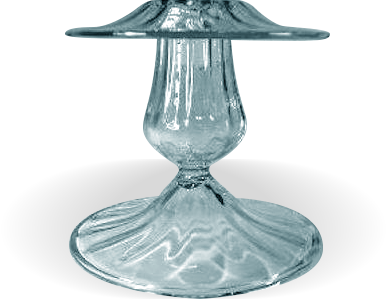
Blue-Gray = Antique Green
There are any number of Steuben colors that are listed in various factory records that we do not now know what they look like. Collectors have been known to make up a name for a color if they didn’t know the factory name. Such was the case with “blue-gray”. Recently there has been a great deal of work on Steuben colors being done by Dr. Greg Merkel using X Ray Florescence (see the article below). He has compared the formula generated by X Ray Florescence for a piece of “blue-gray” with formulas for various colors found in Carder’s notebooks. He has found that the formula for “blue-gray” matches the formula for Antique Green.
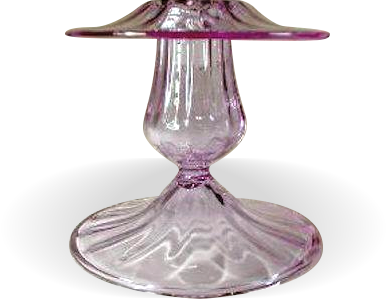
Wisteria
Steuben’s Wisteria is a dichroic glass. It appears to be a different color depending upon the light. In natural or incandescent lighting it appears to be a light pink or lavender. In florescent lighting it is a light blue. The photo is a 6593 Wisteria candlestick shown in florescent lighting on the left and incandescent lighting on the right.
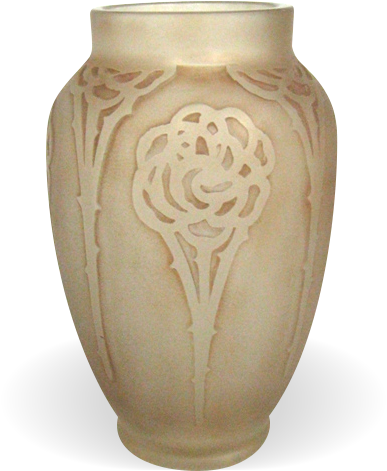
Burnt Umber
Steuben would sometimes finish an acid etched piece by essentially painting it with a brown coating. To quote Paul Gardners The Glass of Frederick Carder page 65, A brown oxide, such as burnt umber or ocher mixed with linseed oil and turpentine, was frequently rubbed into the etched surfaces to accent the design. This color was not fired on, but was a fairly permanent air-dried pigment.This technique was used most often with a single light colored glass such as Alabaster, Calcite or was colorless. The glass shown here is shape 6806 in colorless glass etched in an unknown pattern that may be Trentham. The photo shows an original burnt umber finish. Unfortunately collectors today who are not aware that such a finish exists will often assume that the glass is very dirty and go to some effort to remove the finish. Sometimes pieces will be found where the finish removal has not been entirely successful and the finish will still remain in crevices.
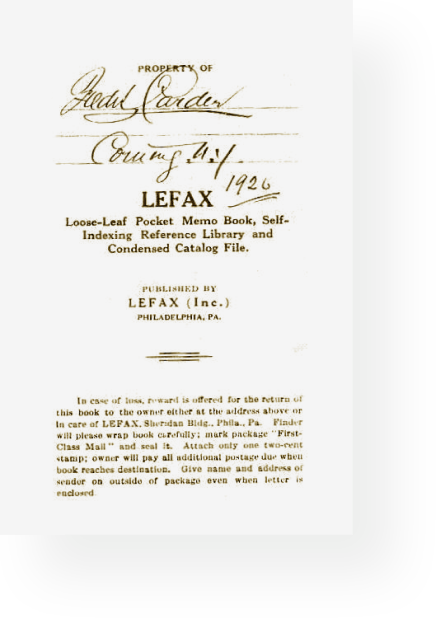
Current Work on Steuben
Colors Carder`s Notebooks
Steuben would sometimes finish an acid etched piece by essentially painting it with a brown coating. To quote Paul Gardners The Glass of Frederick Carder page 65, A brown oxide, such as burnt umber or ocher mixed with linseed oil and turpentine, was frequently rubbed into the etched surfaces to accent the design. This color was not fired on, but was a fairly permanent air-dried pigment.This technique was used most often with a single light colored glass such as Alabaster, Calcite or was colorless. The glass shown here is shape 6806 in colorless glass etched in an unknown pattern that may be Trentham. The photo shows an original burnt umber finish. Unfortunately collectors today who are not aware that such a finish exists will often assume that the glass is very dirty and go to some effort to remove the finish. Sometimes pieces will be found where the finish removal has not been entirely successful and the finish will still remain in crevices.
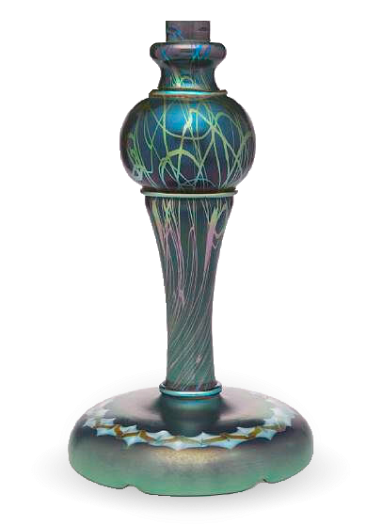
X-ray Fluorescence
Commercial X-ray florescence instrumentation exists that is capable of non-destructively determining the elemental analysis of various materials including glass. The instrumentation is portable, will detect elements between aluminum (atomic number 13) and uranium (atomic number 92) inclusive and, if properly calibrated, will determine the percentage of each element in the material. An effort is presently under way to provide a more definitive correspondence between the factory color names and the colored glassware itself through non-destructive chemical analysis of Carder Steuben objects and an interpretation of their chemistry in light of information within Frederick Carder’s laboratory notebooks. The results of this study form the basis of an upcoming book on the identification of Steuben colored glassware and the chemistry behind its appearance.
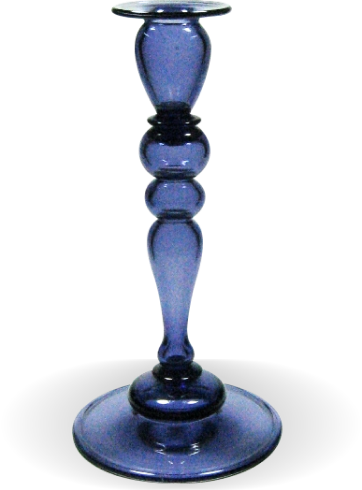
Canterbury
Some recent work (August 2011) using X-ray florescence to analyze two Steuben glass pieces has resulted in defining two colors that were not generally well known. One of these colors is Canterbury and the other is Celadon. Shown here is a 2956 candlestick in Canterbury. A champagne in Celadon is shown below.
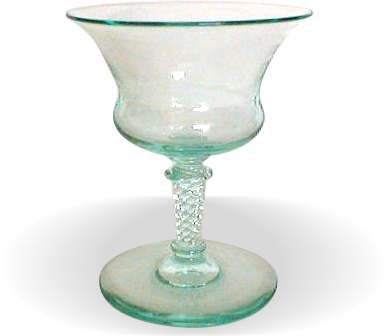
Celadon
This 6692 champagne has been analyzed by X-ray florescence. The analysis shows that the color of this piece is Celadon. This color has earlier been called Window Glass Green and Nile Green but it is, in fact, Celadon. Celadon contains Uranium so exhibits florescence in visible light.